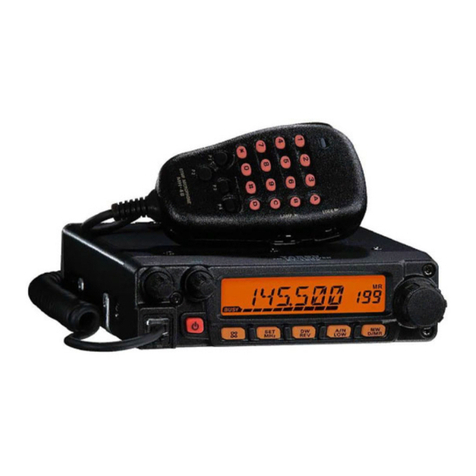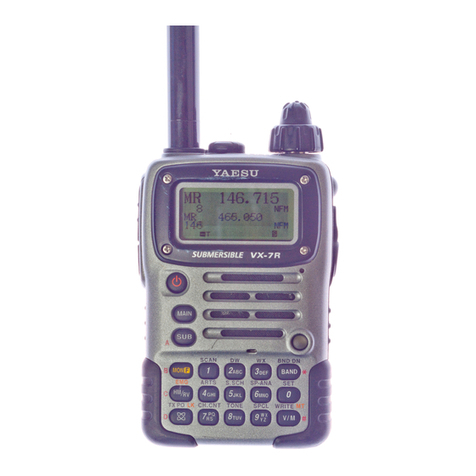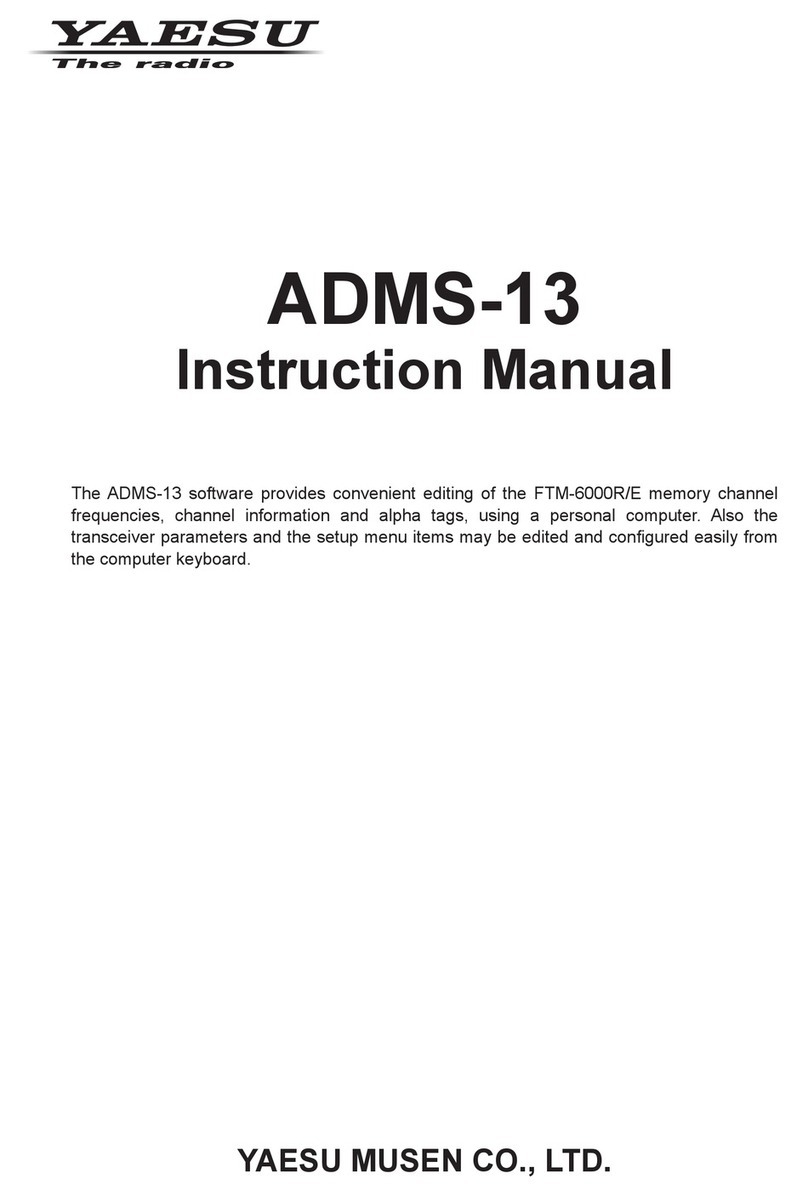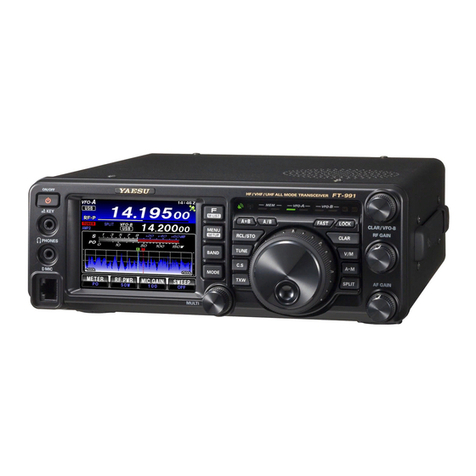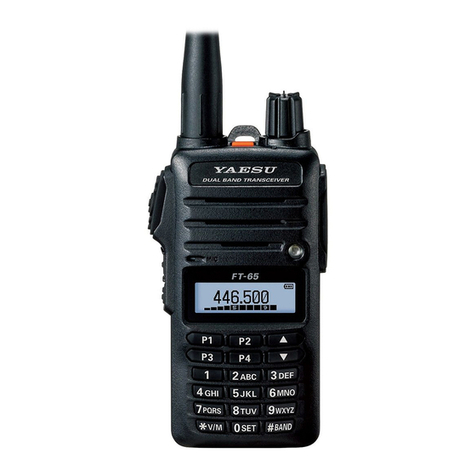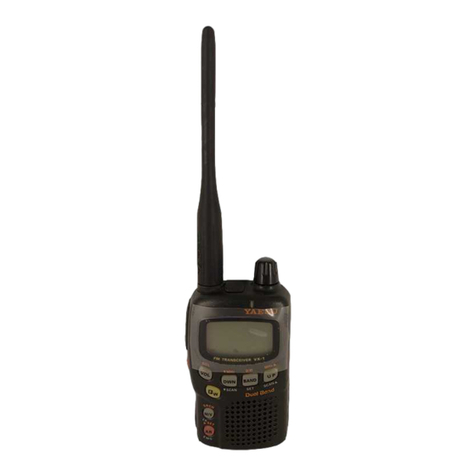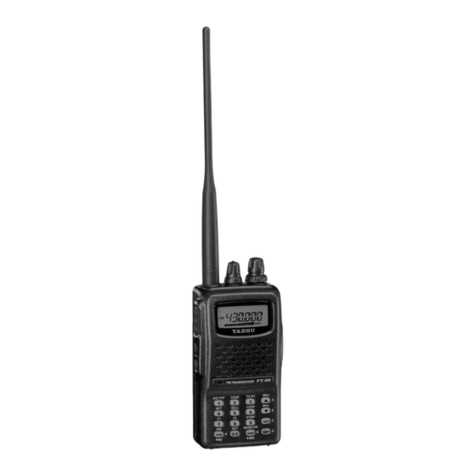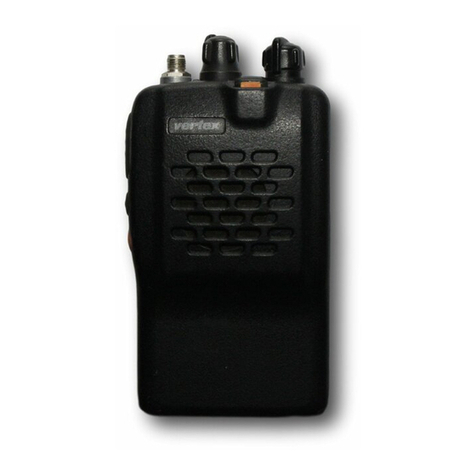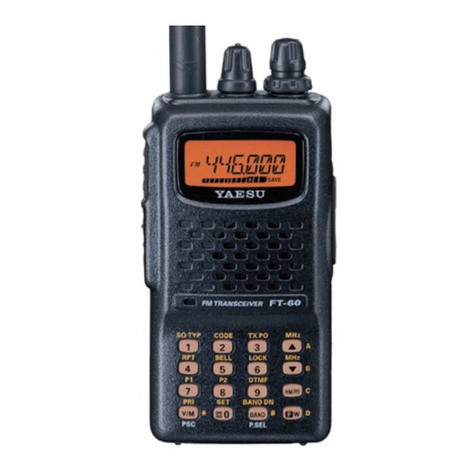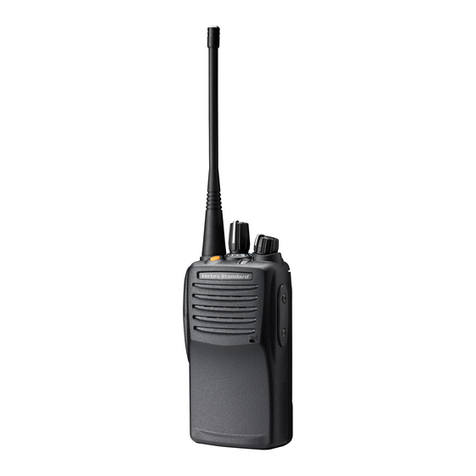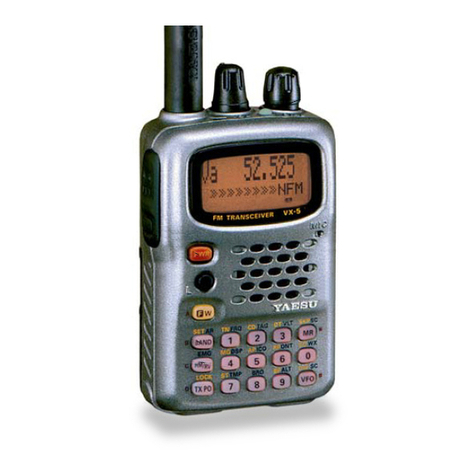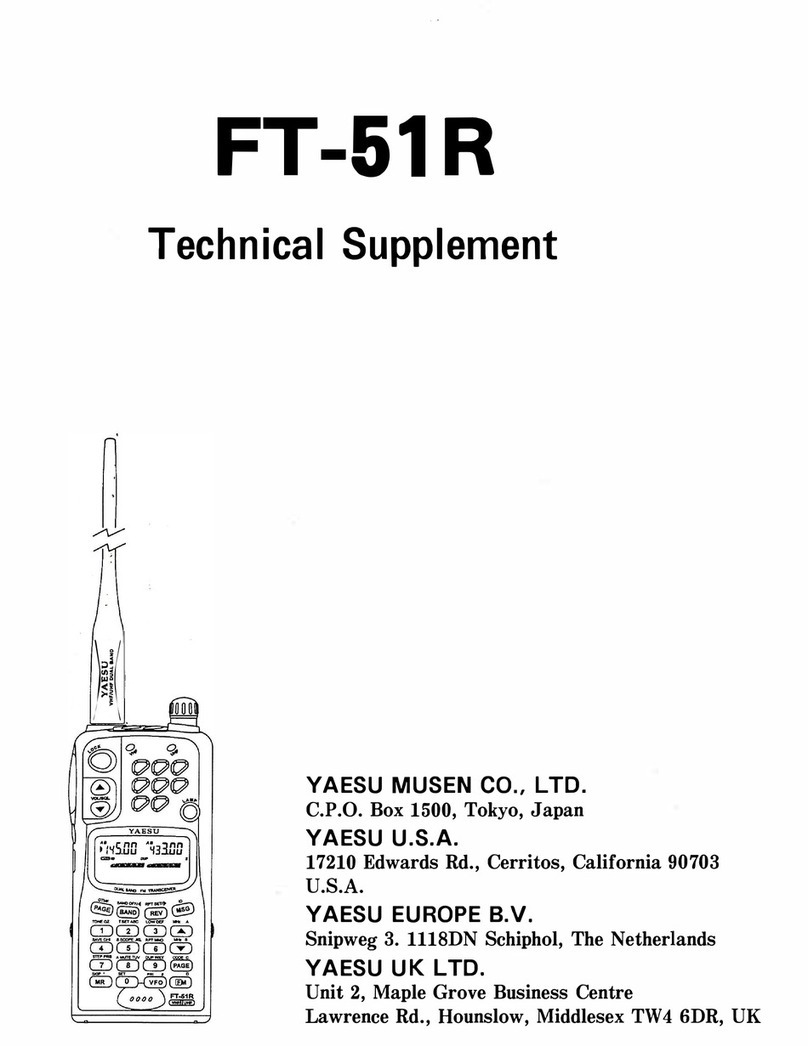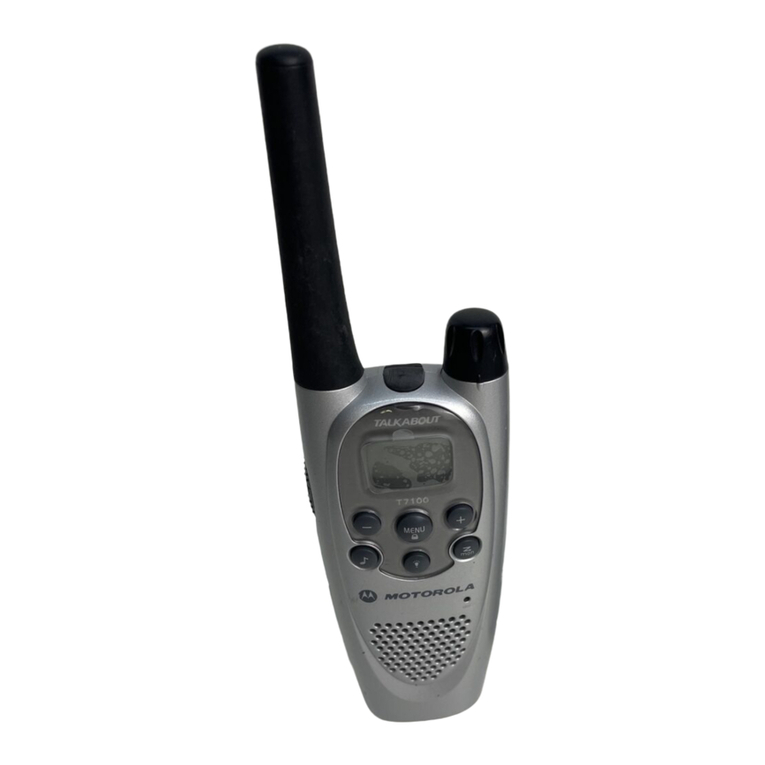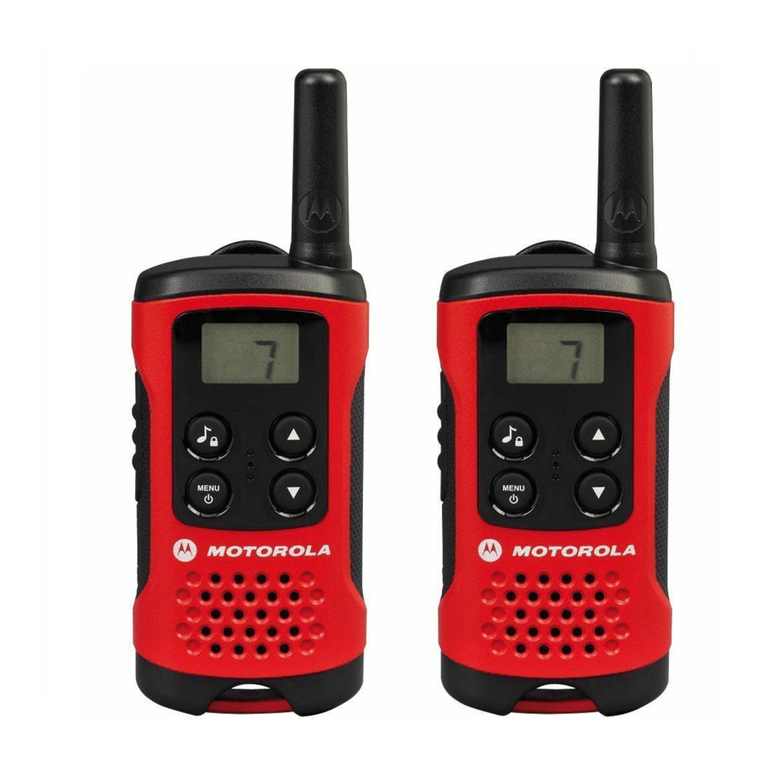
7
Circuit Description
The VX-2R consists of a MAIN-UNIT, a FILTER-UNIT, a
SW-UNIT, and a VCO-UNIT. The MAIN-UNIT contains
the receiver front end, IF circuit, PLL circuit, the CPU,
audio ICs, and the power circuitry for the LCD. The FIL-
TER-UNIT contains the CTCSS/DCS Encoder/Decoder cir-
cuit. The SW-UNIT contains the TX power amplifier cir-
cuit and power switching circuits. The VCO-UNIT con-
tains the transmit/receive local signal oscillator and trans-
mit modulator circuit.
Receiver Signal Flow
The VX-2R includes four receiver front ends, each opti-
mized for a particular frequency range and mode combi-
nation.
(1)Triplexer
Signals between 0.5 and 540 MHz received at the antenna
terminal pass through a first low-pass filter composed of
L1053, L1056, C1300, and C1302.
Received 430-MHz signals, after passing through a low-
pass filter, are fed to the UHF T/R switch circuit composed
of diode switch D1057 (RLS135) and D1059 (1SV307).
Received 145-MHz signals, after passing through a low-
pass filter, are fed to the VHF T/R switch circuit composed
of diode switch D1058 (RLS135) and D1060 (1SV307).
(2)145-MHz Band and 76-300MHz Reception
Received signals between 140 and 150 MHz pass through
the Triplexer circuit, a low-pass filter/high-pass filter cir-
cuit, VHF T/R switch circuit, and protector diode D1002
(1SS362) before additional filtering by a band-pass filter
prior to application to RF amplifierQ1005 (2SC5555). The
amplified RF signal is passed through aband-pass filter
to first mixer Q1014 (2SC5555). Meanwhile, the first lo-
cal signal for the VHF band from the VCO-UNIT is am-
plified by Q1025 (2SC5374) and applied through diode
T/R switch D1041 (DAN222M) to mixer Q1014 (2SC5555)
as the first local signal.
The 47.25-MHz intermediate frequency product of the
mixer is delivered to the IF circuit.
The TUNE voltage from the CPU is amplified by DC am-
plifier Q1016 (NJU7007) and applied to varactors D1020
(1SV325), D1021 (1SV325), D1022 (HVC369), D1023
(1SV325), D1024 (1SV325), D1025 (HVC369), D1034
(1SV325),and D1035 (1SV325) in the variable frequency
band-pass filters. By changing the electrostatic capacitance
of the varactors, optimum filter characteristics are pro-
vided for each specific operating frequency.
(3)435-MHz Band and 300-540MHz Reception
Received signals between 430 and 450 MHz pass through
the Triplexer circuit, a low-pass filter/high-pass filter cir-
cuit, UHF T/R switch circuit,and protector diode D1001
(1SS362) before additional filtering by a band-pass filter
prior to application to RF amplifierQ1004 (2SC5555). The
amplified RF signal is passed through aband-pass filter,
RF amplifier Q1008 (2SC5555),and another band-pass
filter to first mixer Q1013 (2SC5555). Meanwhile, the first
local signal for the UHF band from the VCO-UNIT is
amplified by Q1024 (2SC5374) and applied through di-
ode T/R switch D1040 (HN2D01FU) to mixer Q1013
(2SC5555) as the first local signal.
The 47.25-MHz intermediate frequency product of the
mixer is delivered to the IF circuit.
The TUNE voltage from the CPU is amplified by DC am-
plifier Q1016 (NJU7007) and applied to varactors D1018,
D1019, D1032,and D1033 (all HVC358) in the variable
frequency band-pass filters. By changing the electrostatic
capacitance of the varactors, optimum filter characteris-
tics are provided for each specific operating frequency.
(4)0.5-76 MHz Reception
Received signals between 0.5 and 76 MHz pass through
the Triplexer circuit, alow-pass filter circuit, T/R switch
circuit,and protector diode D1003 (1SV307) before addi-
tional filtering by a band-pass filter prior to application to
RF amplifier Q1009 (2SC5555). The amplified RF signal
is passed through the band-pass filter to first mixerQ1015
(2SC5555). Meanwhile, the first local signal for the BC/
SW band from the VCO-UNIT is amplified by Q1026
(2SC5374)and fed to mixer Q1015 (2SC5555) as the first
local signal.
The 47.25-MHz intermediate frequency product of the
mixer is delivered to the IF circuit.
The TUNE voltage from the CPU is amplified by DC am-
plifier Q1016 (NJU7007)and applied to varactors D1026
(HVR100) in the variable frequency band-pass filters. By
changing the electrostatic capacitance of the varactors, op-
timum filter characteristics are provided for each specific
operating frequency.
(5)540 - 999 MHz Reception
Received signals between 540 and 999 MHz pass through
ahigh-pass filter circuit and T/R switch D1005 (1SV271)
prior to application to RF amplifierQ1002 (2SC5277). The
amplified RF signal is passed through aband-pass filter
to first mixer Q1012 (2SC5277). Meanwhile, the first lo-
cal signal for the UHF band from the VCO-UNIT is am-
plified by Q1024 (2SC5374) and applied through diode
T/R switchD1040 (HN2D01FU) to mixerQ1012 (2SC5277)
as the first local signal.
The 47.25-MHz intermediate frequency product of the
mixer is delivered to the IF circuit.
The TUNE voltage from the CPU on the CNTL-UNIT is
amplified by DC amplifier Q1016 (NJU7007) and applied
